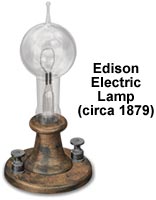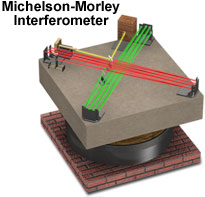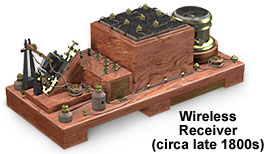
|
1867-1899
The investigation of James Clerk Maxwell's Electrodynamic Theory became the driving force in experimental physics during the final third of the nineteenth century. In 1884, German physicist Heinrich Hertz clarified Maxwell's theory using another method to derive a new set of equations. Since Hertz's equations had been difficult to understand, this won more support for the theory from other physicists.

The crucial test was to determine if electromagnetic waves traveled at the speed of light, as Maxwell had predicted. From 1885 to 1889, Hertz performed a series of experiments that proved the theory. In 1888, he showed that electricity could be transmitted in electromagnetic waves, that they did, in fact, travel at the speed of light, and like known transverse waves (such as light and heat) they could be focused, polarized, reflected, and refracted. During his experiments, Hertz inadvertently observed the photoelectric effect, a phenomenon in which certain metals become electrified when exposed to light. Although he didn't continue to research it, other scientists did and at the turn of the century, it would create yet another revolution in the theory of light.
With the acceptance of the wave theory of light, scientists assumed that for light to travel across space, there must be some medium to carry the waves. This medium, called ether, was assumed to permeate all of space and quickly became a subject of study as science developed more sophisticated tools. To measure the speed of the Earth as it traveled through the ether, Albert Michelson, a German-born American physicist, invented a device called the interferometer. The device was designed to split a beam of light in two, send the two beams along perpendicular paths, and then bring them back together. From the interference patterns of the recombined beams, he could make precise measurements, comparing the speeds of the separated light rays.

To his surprise, the results showed no change in speed between the two light beams. If there was ether, there should have been a difference in speed between them. He tried again with improved equipment and a collaborator, American physicist Edward Morley, and again could not find evidence that the Earth was traveling through the ether. Space, to everybody's consternation, appeared to be mostly empty, begging the question, "How do light waves travel through a vacuum?"
Meanwhile, scientists and inventors were attempting to transmit electromagnetic waves through the atmosphere. While Hertz had succeeded in producing and receiving radio waves during his experiments in the mid-1880s, it was only across a short distance. In 1892, Nikola Tesla arrived at the basic design for a radio. Four years later, in 1896, Italian electrical engineer Guglielmo Marconi succeeded in transmitting a radio signal 1.5 miles (2.4 kilometers). Within a few years radio signals were being broadcast and received at distances up to 200 miles (322 kilometers).

During this period, the fields of microscopy and spectroscopy continued to evolve. Although microscopes were being improved upon, Ernst Abbe revitalized the field of optics when he developed a detailed theory on image formation (1873). The invention of roll film by George Eastman (1885) puts photography into the hands of the general public by the end of the century and inventors began to put pictures into motion.
| 1867 - 1899 |
| 1868 |
Sir William Huggins (England) develops an innovation for the use of spectroscopy in astronomy. He is the first to measure the radial velocity (the motion along the line of sight) of a star by using the Doppler shift of its spectral lines. |
| 1871 |
John William Strutt, Lord Rayleigh (England), offers a mathematical explanation of the particle scattering that makes the sky look blue. |
| 1872 |
Bausch & Lomb start manufacturing microscopes. |
| 1872 |
Henry Draper (USA) is the first to photograph the spectrum of a star (Vega). |
| 1873 |
Ernst Abbe (Germany) provides a detailed theory of image formation in the microscope. He relates the wavelength of the light used for illumination and the aperture of the microscope to its ability to resolve minute structures in microscopic objects. |
| 1875 |
John Kerr (Scotland) discovers that certain materials become doubly refracting when placed in areas affected by strong electric fields. |
| 1876 |
While Ernst Abbe experiments with the effects of diffraction on image formation, he discovers that if you completely correct all of a lens aberration, the actual resolution will be near that of the maximum theoretical resolution. He suggests various theories for improving current microscope design. |
| 1878 |
Improved oil-immersion objectives are produced by Ernst Abbe and Carl Zeiss. |
| 1879 |
Thomas Alva Edison (USA) invents the electric light bulb. |
| 1879 |
Marie-Alfred Cornu (France) improves the measurement of the speed of light and carries out a photographic study of radiation in the ultraviolet. |
| 1880 |
Alexander Graham Bell (USA) invents the photophone, a communications device that uses reflected sunlight instead of wire to transmit electrical signals. |
| 1881 |
An American engineer, William Wheeler, patents a system of internally reflective pipes to guide light from a central intense source to locations throughout a building. This form of lighting is impractical at the time and the light bulb becomes the more practical method of artificial lighting. |
| 1881 |
Étienne-Jules Marey (France) invents the "photographic gun," the world's first portable motion picture camera. The device uses a rotating photographic glass plate that takes twelve consecutive pictures per second. |
| 1881 |
Frederick Ives (USA) invents and patents the halftone engraving process that makes it possible to reproduce photographic images in the same operation as printing text. |
| 1881 |
Albert Abraham Michelson (USA) invents the interferometer and makes his first measurements to determine the speed of the Earth as it travels through the hypothetical ether. |
| 1882 |
Lewis Latimer (USA) develops and patents a process for efficiently manufacturing carbon filaments for incandescent lamps. |
| 1884 |
Physicist Heinrich Hertz (Germany) uses a new method to derive equations for Maxwell's Electrodynamic Theory, clarifying the theory and better defining the relationship between electric and magnetic fields. |
| 1884 |
German engineer Paul Nipkow patents his concept for a complete electromechanical television system. The key piece is the Nipkow disc, a rotating disc with holes in a spiral pattern that makes it possible to scan and electrically transmit moving images. |
| 1885 |
Physicist Henry Rowland (USA) completes a machine that can engrave as many as 20,000 lines to the inch for diffraction gratings. He uses it to rule gratings on spherical concave surfaces, eliminating the need for additional lenses and mirrors in spectrometers, which allows for more precise measurements. |
| 1885 |
Johann Jakob Balmer (Switzerland), a mathematician and schoolteacher, announces a simple formula that predicts the positions of the spectral lines of hydrogen ("Balmer series"). |
| 1885 |
S Andromeda is the first supernova (SN 1885A) to be discovered and studied in modern times. |
| 1885 |
George Eastman (USA) begins marketing the world's first commercial film. Transparent and flexible, it is cut into narrow strips and wound on a spindle for use. |
| 1886 |
Schott and Associates, Inc. produce apochromatic lenses that correct chromatically for three colors simultaneously. |
| 1886 |
Following the work of his predecessor, Ernest Abbe, microscopist Carl Zeiss produces a light microscope with lenses capable of resolving images at the theoretical limit of visible light. This is possible through the use of a microscope corrected for both spherical and chromatic aberration, applying Kohler illumination with matched substage condenser lenses and apochromatic objectives. |
| 1887 |
Albert Michelson and Edward W. Morley (USA) announce that after years of experiments to measure how fast the Earth is traveling through the hypothetical ether, there is no evidence of an ether permeating space. |
| 1887 |
While conducting experiments in electromagnetism, Heinrich Hertz accidentally discovers the photoelectric effect. |
| 1888 |
Heinrich Hertz performs a series of experiments that prove James Clerk Maxwell's theory of electromagnetic waves (1865). |
| 1891 |
W. K. Laurie Dickson of the Thomas Edison Laboratory (USA) invents the first celluloid film motion picture camera, the Kinetograph. The films are displayed with the Kinetoscope (Motion Picture Viewer, or Peepshow), which was developed shortly after the Kinetograph. |
| 1892 |
Nikola Tesla creates the basic design for a radio and receives a patent in 1898 for a radio-controlled boat. |
| 1895 |
Thomas Edison investigates several thousand materials for their ability to fluoresce under X-ray exposure. He concludes that calcium tungstate is the most effective substance. By March 1896, his fluoroscope will be the standard tool for medical X-ray examinations. |
| 1896 |
Guglielmo Marconi (Italy) invents the wireless telegraph and receives a patent for it in London, his patent request in Italy having been turned down. |
| 1895 |
Physicist Wilhelm Wien (Germany) studies black body radiation and determines the mathematical relationship between the temperature of an object and the radiation it emits. His findings show that the color of a star indicates its temperature, not that it is approaching or receding from the Earth as Doppler had thought. |
| 1897 |
Sir Joseph John Thomson, an English physicist, concludes from his experiments that all matter contains tiny electrified particles called electrons (originally, he calls them corpuscles). |
|
|
 |
 |
 |
BACK TO TIMELINE IN OPTICS HOME
Questions or comments? Send us an email.
© 1995-2025 by
Michael W. Davidson
and The Florida State University.
All Rights Reserved. No images, graphics, software, scripts, or applets may be reproduced or used in any manner without permission from the copyright holders. Use of this website means you agree to all of the Legal Terms and Conditions set forth by the owners.
This website is maintained by our
Graphics & Web Programming Team
in collaboration with Optical Microscopy at the
National High Magnetic Field Laboratory.
Last Modification Friday, Nov 13, 2015 at 01:18 PM
Access Count Since August 1, 2000: 58252
Visit the websites of our partners in education:
|



